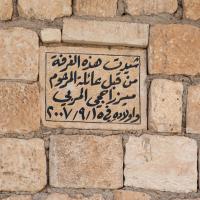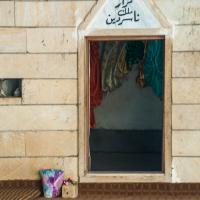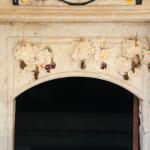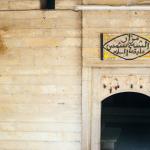Site Profile
The mausoleum of Shaykh Shams is one of the many sacred buildings that stand throughout the valley of Lalish in northern Iraq. The structure is dedicated to a 12th-century saint who was later identified with the Yezidi god of the sun. It is found southwest of the central sanctuary of Shaykh ‘Adī, just uphill from the Kaniya Spi. The mausoleum, probably founded shortly after the saint’s death, is among the most venerable shrines of Lalish. An important communal ritual performed here involves the sacrifice of a bull during the annual Feast of the Assembly (Cejna Jema’iyye).1
- 1. The sacrifice occurs on the fifth day of this festival and takes place at a basin in front of the mausoleum (Açikyildiz 2010, 105–106). Another bull sacrifice is performed at the festival called the Forty Days of Summer (Chilê Havinê; ibid., 110).
Media
Description & Iconography
Inscriptions
Only modern inscriptions are found throughout the Mausoleum of Shaykh Shams, including:
2. Arabic inscription at another entrance: “To the Mausoleum of Bab al-Shamsani.”
History
Little is known about the historical personage of Shaykh Shams (full name: Hasan ibn ‘Adī Shams ad’Din), but he is said to have been in Lalish when Shaykh ‘Adī arrived there to preach in the 12th century AD. He went on to succeed his father, Ezdina Mir, as the leader of the Yezidi community. He was eventually deified—becoming one of the seven angels meeting annually at the shrine of Shaykh ‘Adī to determine the course of the year—and was identified with the god of the sun.1 Five mausolea dedicated to Shaykh Shams are known throughout different Yezidi sanctuaries.2
The chronology of the structure documented by MMM in the valley of Lalish is not entirely certain. The core of the building—the antechamber and mausoleum—was likely constructed in the 12th century, with the northern hall and other features added later. Even the structure’s core has been modified since the 1940s, as it differs from the shrine described by travelers of the early 20th century (see further in “Early Publications”).
Early Publications
Shaykh Shams’ mausoleum is described by several of the travelers who visited the Lalish sanctuary in the 19th and early 20th centuries, including Austen Henry Layard (mid-1840s), Cecil J. Edmonds (1930s/1940s), and Ethel S. Drower (1940).1 The latter observes a number of features along the shrine’s portal which are no longer extant, including carvings of a star, crescent, and cone-spire, as a well as a snake to the right of the door. Most early photographers at the Lalish sanctuary focused on Shaykh ‘Adī’s temple, but Shaykh Shams’ dome was photographed by Wilfred Patrick Thesiger in 1950 (see the historical photograph).
- 1. Layard 1849 (1): 289–290; Edmonds 1967, passim; Drower 1941, 161–162.
Selected Bibliography
Açikyildiz, Birgül. 2010. The Yezidis: The History of a Community, Culture, and Religion. London: Tauris.
Drower, Ethel S. 1941. Peacock Angel. London: J. Murray.
Edmonds, Cecil J. 1967. A Pilgrimage to Lalish. London: Royal Asiatic Society.
Layard, Austen Henry. 1849. Nineveh and Its Remains. 2 vols. London: J. Murray.



























